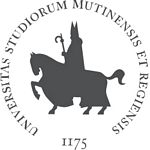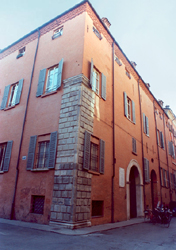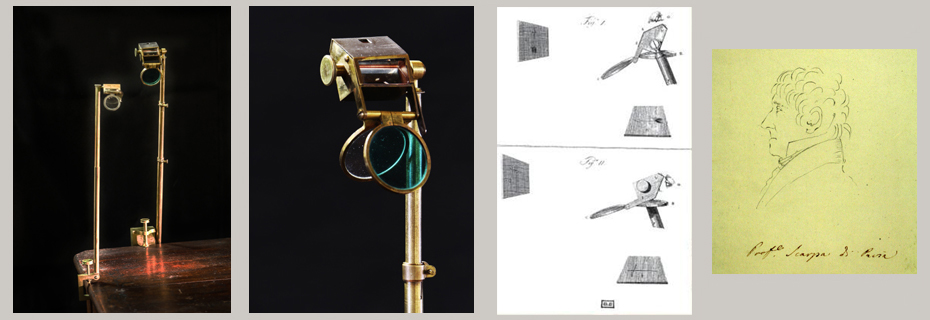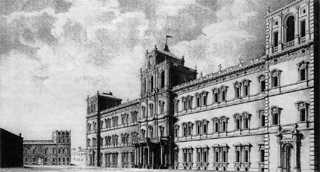Itinerario a cura dell'UNIVERSITÀ DI MODENA E R. EMILIA 


Giovanni Battista Amici was born on March the 25th 1786 in Modena from Giuseppe Amici Grossi e Maria Dallocca. In 1806 he married Teresa Tamanini and they had three children: Vincenzo (born in 1807), Elena (born in 1808) and Valentino (born in 1810). He studied first in Modena where he attended, inter alia, lessons of Geometry and Analysis from Paolo Ruffini (1765-1822), mathematician of international renown. In 1808, he graduated Architect and Engineer at the Bologna University. Between 1811 and 1825 he taught Algebra, Geometry and Plane Trigonometry in Gymnasium first, then at the Modena University.
In his home located in Servi street, where the Royal Printing House Eredi Soliani (owned by Amici’s Family) is placed, he built his laboratory for the construction of scientific tools. Also thanks to the encouragement of Giovanni Battista Tomaselli, physics professor at Modena University, already in 1809, Amici started to experiment with melting of metal alloys and curvature of lenses together with printing house’s workers, among the others Giuseppe Sgarbi, who worked as his collaborator till 1831.

In 1811, two years later, his Newtonian reflecting telescope, the biggest ever built in Italy, was presented in Milan on the occasion of the National Exhibition promoted by the Royal Science Institute. The Brera astronomers judged it as “equal to the Herschellian’s one”: the telescope presents in Brera Observatory built by the German astronomer William Herschel. Herschel (1738-1822) built his telescope taking inspiration from the one of Isac Newton in 1668, introducing some important innovations.
In November 1811, Amici built for Brera a second telescope with a focal length of around 17 Parisian feet (5,20 meters) and a width of 11 inches (30 centimeters): it was the biggest reflector ever built in Italy. Because of the good reviews, Amici was motivated to go on with the experimentations in the optical field. In 1812 he built his catadioptrical microscope, or reflecting microscope, that is with mirrors instead of lenses, as inverted application of a Newtonian telescope.
The microscopist and histologist John Quekett (1815-1861) wrote in his Practical Treatise on the Use of the Microscope (1848) that a new age started around 1815 in the microscopical science field in England with the improvements introduced by Amici with the reflecting microscope.

Following initial good results, between 1812 and 1813 several reflecting telescopes were built in his Modena laboratory. Among these one for the Capodimonte Observatory in Naples that in that period had to be put up, one for the Bologna Observatory, one for the Padua Astronomic Observatory.
In December 1814, Paolo Ruffini presented to the Italian Science Society, with seat in Modena, the first scientific Memoir of Amici Description of a new micrometer, which was published in «Physics and Mathematics Memoirs» of the same Society.
Thanks to this instrument, made for his own observations, Amici had the possibility to observe the austral polar ice cap of Mars. In 1817, for the first time Amici travelled from Modena to Naples through Bologna, Florence and Rome. During this travel he met important official acquaintances, astronomers, naturalists, geodesists and cartographers, so that his instruments could be appreciated and he could find several work orders. Most appreciated were his camera lucidas. In 1819, he published the results of his research on Bologna «Scientific Pamphlet» with a contribution titled Over the camera lucidas. This memoir was read in the Royal Science, Letters and Arts Academy of Modena on the 27th of February 1818.
The accounting book of the laboratory (Libro de’ conti) recorded the sales of around 270 instruments. With its camera lucida Amici portrayed relatives, friends and several guests of his studio both in Modena and in Florence.

Amici met the most important exponents of the international scientific community with whom he entered into a steady correspondence. Between 1819 and 1822, he began to build microscopes, telescopes, spyglasses, micrometers, repeating circles, camera lucidas, and a navigation instrument, a reflecting prism sector which was appreciated by the Hungarian astronomer from Gotha, Franz Xaver von Zach (1754-1832).
In 1823, he built a new prismatic micrometer that he mounted between the lens and the eyepiece of catadioptric and dioptric telescopes.
The year 1824 is worldwide considered as the year of birth of the modern achromatic compound microscope. The reading of the report about the microscope of Alexandre François Gilles known as Selligue (1784-1845), written by French physic Augustin Jean Fresnel (1788-1827) at the Science Royal Academy of Paris, motivated Amici to restart his attempts with achromatic lenses. In order to achieve an high definition, he composed his objective of lenses, which single aberrations, in other words images alterations, neutralized each others.

In spring 1827, Amici went for the first time to Paris and London with its reflecting prism sector, the new double image micrometer, a reflecting mirror with a 12 inches diameter and a focal length of 20 feet, catadioptric and achromatic microscopes. The reflecting mirror was ordered from English astronomer John Frederick William Herschel (1738-1822) on account of his English astronomer friend, Reverend Thomas John Hussey (1792-1854). Amici’s son Vincenzo wrote the memories of this travel.
In London he compared his new achromatic tool with the one of Joseph Jackson Lister (1827-1912), the biggest microscopical optic expert of England. This new instrument played an important role in the studies about plant fertilization process.
In 1827, the new Astronomic Observatory of Modena held in the Eastern tower of Ducal Palace, was opened. It was headed by Giuseppe Bianchi (1791-1866), Theoretical Astronomy Professor at the Modena University. Amici built for him a transit instrument, an equatorial (today lost), a Newtonian telescope and a double image micrometer for a Dollond telescope.
On the 4th of March 1831, following the Carbonari uprising leaded by Ciro Menotti and the escape of Archduke Francesco IV of Austria-Este (1779-1846, duke from 1814), in Modena a Provisional Government named Giovanni Battista Amici Public Instruction Prefect. The rapid comeback of Archduke Francesco IV (on March the 9th) prevented Amici to take this position.
At the Leopold II of Hapsburg Lorraine grand duke of Tuscany (1797-1870, grand duke from 1814) invitation, on the 23rd of December 1831, Giovanni Battista Amici moved to Florence to become Director of the Observatory of Physics and Natural History Museum. That role was free after the death of astronomer Jean Louis Pons. In the Tuscan capital Amici went on with the construction of scientific instruments. He worked in two laboratories, one in the Florentine Observatory (the Specola), the other private located in his home, the Demidoff Palace in De’ Renai street, bought in 1840. In 1836 he built a prism reflecting circle. Thomas R. Robinson, Director of Armagh Observatory in Ireland, wrote that the Amici’s instrument was embarked on the boat of HMS Erebus leaving for Antarctic expedition (1839-1843) captained by James Clark Ross. In 1839, Amici together with important experts signed the document for the First Meeting of Italian Scientist in Pisa. The target was to gather periodically the Natural Science Experts of the whole country as in the rest of Europe. In 1841, during the Third Meeting in Florence, he presented a refracting telescope with 28 centimeters width lenses and 5,3 meters of focal length. It was built in the workrooms of Royal Physics and Natural History Museum of Florence. This instrument, known as Amici I, remained for 40 years long the refracting telescope with the biggest width in Italy.
In 1842, from the Georgofili Academy of Florence, he reported the researches of William Henry Fox Talbot to print the images on the paper with the exposition to the light, photographic process known as calotype. In the same year, during the Fourth Meeting of Italian Scientists in Padua, Amici revealed his observations about plant fertilizations (Cucurbita Pepo, i.e. marrow) which caused an hard attack from German Botanic Matthias Jacob Schleiden.
In 1844 the «Annales de Chimie et de Physique» published an Amici’s memoir about polarizing microscope invented in 1830.
This instrument achieved huge success in Paris and it was used in mineralogy and crystallography from three generations of directors of Mines School.
Always in 1844, he travelled for the second time to Paris and London, stopping by the comeback in Berlin, Vienna and Munich. During this trip he met several experts and showed them his instruments.
In Berlin, together with naturalists Alexander von Humboldt and Christian Gottfried Ehrenberg he visited the microscope builder Friedrich Wilhelm Schiek.
The son Vincenzo in a letter dated 21 of June sent from Paris to Giovanni Battista Lenna, chief of Florence Laboratory, wrote: «Here, the instruments built by my father achieved a huge success, because they are better than those produced in Paris».
In 1845, he built a second big achromatic lens for a telescope (23 centimeters width with 3,18 meter of focal distance), named Amici II.
In 1846, during the Eighth Meeting of Italian Scientist in Genoa, Amici presented a report of historical importance about the orchids fertilization, where he described for the first time the whole process.
In 1847, Amici applied for the first time the principle of immersion in water of the lower part of lenses. This discover represented a fundamental contribution to the evolution of microscopic optics. In 1852, the Georgofili Academy invited him to take part in the Commission named to study the grape disease which infested the Tuscan vineyards. Until 1862, he did several microscopic observations on the grape cryptogam (OidiumTuckeri) and on the wheat diseases, mulberry diseases and silkworm diseases.
In 1855, when he was 69, he did his third and last trip to Paris on the occasion of the Exposition Universelle. There, his lenses, «modified in order that the plane of half of sphere could be immersed in water or in poppy seed oil, achieved a great success».
At the end of 1859, he was relieved from his role of Director of Astronomic Observatory of Royal Physics and Natural History Museum. Because of his age, this task became too heavy for him and he was titled honorary astronomy professor and person in charge of microscopic observations by the Royal Physics and Natural History Museum of Florence. His last invention, the direct vision prism to be used by the observations of stellar spectra, was done between 1857 and 1860. In 1861, he was President of the Jury Commission for IX Class, Precision Mechanics and Physics, by the Italian Exposition held in Florence. Thanks to his works and the creation of optic instruments appreciated and imitated worldwide (in that period these were the unique exported high technology instruments from Italy) he showed how the work of scientist and instrument builder should work in synergy spurring them each other. In the same time he gave birth to the modern tradition of Florentine optic, which thanks to the work of Giovanni Battista Donati, a collaborator of him by the Observatory (the Specola) of Royal Museum, will take to the creation of Galileo workshop in 1870.
On the 10th of April 1863, Giovanni Battista Amici died in Florence.
A 54 kilometers of diameter crater located on the hidden side of the moon and the 3809 planet have today his name.
1786 Giovanni Battista Amici was born the 25th of March in Modena from Giuseppe Amici Grossi e Maria Dallocca
1808 he degreed Engineer and Architect at the Bologna University
1811-1825 taught Algebra, Geometry and Plane Trigonometry in Gymnasium first, then at the Modena University
1811 Received the gold medal for the construction of reflecting microscope, judged from Brera Astronomers «equal to the Herschellian’s one»
1812-1813 Some reflecting telescopes, a new lens bisected micrometer and catadioptric microscope were built in his laboratory
1817 For the first time Amici made a long travel from Modena to Naples through Bologna, Florence and Rome. Most appreciated were his camera lucidas.
1821 He invented an achromatic telescope without lenses and with a unique refracting tool and an iconantidiptic telescope
1822 He invented a navigation instrument: a reflecting prism sector very appreciated from Baron von Zach (Sur un nouvel instrument de reflexion)
1823 He built a new prismatic micrometer. He put it between the lens and the eyepiece of dioptric telescopes or between the mirror and eyepiece of catadioptric telescopes in order to measure planets diameter, sun diameter, distance and position of double and triple stars.
1825 He made observations of Jupiter’s satellites in broad daylight.
1827 During the summer, he travelled for the first time to Paris and London, where he presented his instruments to the Scientific Community. In August, the new Observatory was inaugurated in Modena. It contained his Transit Instruments, his Equatorial and Newtonian Telescope.
1831 At the invitation of Grand Duke of Tuscany Leopold, Amici left Modena to move to the Pisa University with the new title of Astronomic Professor. The Grand Duke gave him the title of Director of Astronomic Observatory “La Specola” as successor of Jean-Louis Pons
1839 He is one of the first to sign the document for the First Italian Scientists Meeting in Pisa, where he presented his memoir regarding the “Process that permits to the plant ovules to receive fertilization through pollen”
1842 At the Georgofili Academy he reported the William Henry Fox Talbot researches to print the images of the objects on the paper with the exposition to the light.
1844 Second travel to Paris and London. On the way back he went through Berlin, Vienna and Munich.
1846 During the Eighth Meeting of Italian Scientist in Genoa, Amici presented a report of historical importance about fertilization of some kind of orchids (“On the Orchids fertilization”)
1847 applied successfully on his microscopes the principle of immersion in water
1852 The Georgofili Academy included him into the Commission named to study grape disease.
1857-1860 In a indefinite date he built for Giovanni Battista Donati, a collaborator of him by the Observatory (the Specola) of Royal Museum, a direct vision prism to observe the striae of stellar spectra.
1859 He was titled Honorary Professor of Astronomy (in the event he was released from Astronomer functions) and entrusted as person in charge of microscopic observations in the Royal Museum
1861 He presided over the Jury Commission for Precision Mechanics and Physics Class in occasion of the Italian Exposition of Florence
1863 On the 10th of April he died in Florence
 Bologna
Bologna  Florence
Florence  Rome
Rome  Paris
Paris  London
London  Berlin
Berlin  Vienna
Vienna  Munich
MunichMeschiari A. (2014). Microscopi Amici nella ricerca scientifica. Firenze : Fondazione Giorgio Ronchi.
Meschiari A. (Ed.) (2006). Edizione nazionale delle opere e della corrispondenza di Giovanni Battista Amici. Napoli: Bibliopolis; [poi] Firenze: Fondazione Giorgio Ronchi.
Longo B. (1928). Sopra un cimelio della scoperta di G. B. Amici sulla fecondazione delle piante. Atti della Società toscana di scienze naturali, 39.
De Toni G. B. (1923). Giovanni Battista Amici. In Mieli A. (Ed.). Gli scienziati italiani dall'inizio del Medio Evo ai nostri giorni. vol. 1. (p. 78-83). Roma: Casa editrice Leonardo Da Vinci.
Briosi G. (1908). Giovanni Battista Amici. Cenno sull'opera sua e ritratto. (p. III-XXVI). Atti dell'Istituto botanico dell'università di Pavia, s. 2, 11.
De Toni G. B. (1906). Di una interessante scoperta del modenese Giovanni Battista Amici e de' suoi progressi. (p. 39). Annali della R. Università di Modena, Modena.